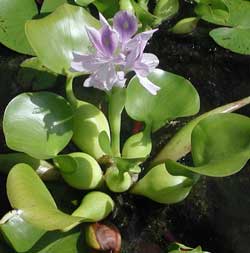Resource Library
Plant of the Week: Water Hyacinth
The University of Arkansas System Division of Agriculture does not promote, support or recommend plants featured in "Plant of the Week." Please consult your local Extension office for plants suitable for your region.
Plant of the Week
Water Hyacinth
Latin: Eichhornia crassipes

Live long enough and you begin to realize life is a balancing act. It's a balance between things we want and things we need; between things good for us and things likely to harm us; and between things we know and things we believe.
Sometimes we get to decide the appropriate balance for ourselves; sometimes Big Brother makes the decision for us. The recent ban on the sale and distribution of a popular water garden plant in Arkansas is an example of trying to strike an appropriate balance.
The plant in question is water hyacinth (Eichhornia crassipes), a floating perennial herb that has become a serious weed in the Gulf Coastal states since its introduction from Brazil at an 1884 exposition in New Orleans.
In infested areas, waterways become clogged each summer with water hyacinths that crowd out other species, interfere with sports fishing and ensnare thousands of boat propellers.
Though usually killed by frost, recent mild winters have allowed a some populations to overwinter in protected places in Arkansas waterways on the Arkansas and Ouachita rivers.
Water hyacinth is a fast growing plant capable of holding its rosette of glossy-green, waxy leaves up to two feet above the water. The leaves are trowel shaped with a conspicuously swollen petiole (stem of the leaf) that's spongy and aids in floating.
Each rosette forms a series of floating stolons (horizontal stems) that radiate in all directions and terminates in a new rosette of leaves. The plant quickly forms large floating mats that blow around with the wind. In ideal conditions such as Florida, the size of a colony can double in size in 6 to 10 days when the water temperature is around 85 degrees.
The common name is a reference to the flowering spike that shoots from the whorl of leaves during the summer months. Eight to 15 lavender to bluish flowers are produced on stems that reach a foot in height.
In May, the Arkansas State Plant Board added the water hyacinth to the prohibited plants list for the state. Four plants - purple loosestrife, giant salvinia (a floating fern), Japanese blood grass and water hyacinths - have now been deemed too potentially invasive to risk sale as ornamentals.
The ban prohibits in-state sales and importation of the plant from out-of-state nurseries.
Water hyacinth has been popular in sunny water gardens throughout the state for a number of years. Don't expect roving bands of plant inspectors to knock at your door and inspect your water garden for this now-banned plant. But, unless you can overwinter it yourself, you won't be able to buy it in future years.
It wasn't too long ago when water hyacinth was considered a good-guy in the fight to improve water quality. In the 1980s, researchers looked at using the fast growing water hyacinth in greenhouses located beside sewage treatment plants. The submerged roots were intended to filter out nitrates and phosphates in the sewage water and provide an environmentally friendly tertiary water treatment system. The plants that were produced were to be converted to pig feed.
How real is the threat imposed by water hyacinth in Arkansas waterways?
It's hard to say, but that is where the balancing act comes into play. Attempts at eliminating well established species from locations where they have become firmly entrenched aren't promising. But attempts to keep invaders out that are not well adapted, as is the case here, usually prove more effective.
By: Gerald Klingaman, retired
Extension Horticulturist - Ornamentals
Extension News - July 21, 2006
The University of Arkansas System Division of Agriculture does not maintain lists of retail outlets where these plants can be purchased. Please check your local nursery or other retail outlets to ask about the availability of these plants for your growing area.